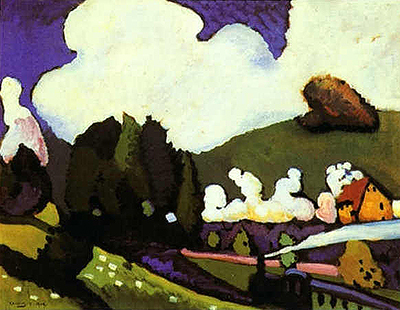Landscape with a Steam Locomotive was completed in 1909 by Wassily Kandinsky and is one of a number of abstract landscape paintings that he completed around this period.
This artwork is bright and uplifting thanks to the tones of white used by the artist which dominate the top half of the composition. Behind the green rolling hills is a bright blue sky with large clouds floating their way across the scene. We see a few houses decorating the centre, along with the locomotive which drives its way across the painting, releasing a white stream of smoke. Kandinsky sticks to fairly realistic colours in this painting that bear some resemblance to what he would have witnessed at the time, though the palette is still relatively limited in order to give this contemporary finish. Kandinsky was trained in more traditional styles of working, but simply liked to work in this way instead. In the foreground he dabs white paint to signify sheep and continue the theme of relaxing in the countryside, with a perfect balance between nature and the impact of humanity.
It is pleasing that in recent years there has been a growing acceptance of the qualities of the artist's work in this genre, when previously he had been only really known for his use of abstract, geometric shapes. Exhibitions are attempting to provide more varied and deep summaries of artist's work in order to keep their displays fresh and interesting. There has also been good collaboration between different art institutions in order to allow these exhibitions to travel to several different venues and also to pool together different collections for this short period.
Landscape with a Steam Locomotive is now a part of the respected collection of the Guggenheim Museum. They actually own a number of artworks from this artist's career and also serve up a many related artists alongside Kandinsky as well. We can find connections between his career and many other major names from the early 20th century art scene, some of whom he collaborated with or influenced. His knowledge of colour, for example, can remind many of the work of Klee and Matisse, whilst his progression towards greater abstraction also bears similarities to the career paths taken by the likes of Miro and Mondrian. All that said, his career can be considered entirely unique and remains an inspiration to many young artists today who draw on all of the different genres in which he became involved in across the full breadth of his career.




